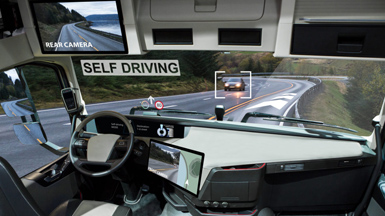With regulations putting ever-growing burdens on the modern trucker, logistics is moving sideways instead of pushing back. While self-driving cars are a frequent subject of debate in the news, consumer demand for faster shipping and lower prices have made self-driving trucks a very appealing solution for moving goods across the country and, eventually, across the world. Here’s why the next time you see a big rig, the passenger seat might not be occupied:
The ROI is Higher
Consumer demand isn’t slowing, and with trucking professionals aging out or switching careers, there simply aren’t enough young drivers feeding into the system for it to be sustainable. Provided drivers don’t buy into their own rig as an owner/operator, the relatively reasonable cost and time to secure a CDL license doesn’t make a job change prohibitive. With gas prices edging up, there are little to no incentives beyond a paycheck to coax new talent into the industry. That means that trucking companies are facing an unprecedented shortage of bodies to place behind the wheel, and they’re no longer able to confidently make time guarantees to clients looking for haulers.
While there are research costs associated with developing self-driving trucks, they will eventually level off while profits will continue to grow. Without the need to monitor, for example, how long a driver has been consecutively driving, that corporate energy can be poured into sourcing new routes. With virtually 24/7 driving ability, driver-less trucks can also complete routes more quickly and efficiently, without the exchanges, overnights, and so on required in many long-haul jobs.
Safer Performance
Even the best driver can become sleepy, sick, distracted, or simply make a bad call in the moment. Jack-knifed loads destroy both palettes and brand reputation, and drive insurance premiums through the roof. A few tickets at the wrong time can sideline a driver with a suspended CDL and leave dispatchers scrambling. Each of these issues can, more often than not, be traced back to the human element in the equation. Sensors and cameras don’t have in-built hesitation issues and err on the side of caution – reckless performance wouldn’t do much for driver-less trucking perception, after all.
Cost Savings
A vehicle that makes smooth stops and accelerations uses less gas – in the microcosm of a passenger car, this doesn’t make much of a dent in terms of money spent. Scale up to an 18+ wheeler traveling cross-country, however, and that number becomes far more appealing. Computerized systems can detect with mathematical accuracy exactly how and where a load will shift as a truck speeds up or takes turns and can eventually be programmed to factor these calculations into driving. That means that momentum is preserved, and transported goods arrive undamaged, ultimately saving the logistics company transporting them a great deal of money. The lack of need for a large sleeping cab also means that there is more square footage availability, which means that companies can potentially carry even more goods along a route.
Driver-less trucks aren’t likely to be taking their place on a large scale for at least a few years, but the potential benefits to the logistics industry as a whole are staggering. If safe, sturdy incarnations of these vehicles can be mass-produced with reasonable affordability, the driver shortage in trucking might just become a non-event over time.
If you’re looking for new strategies, let’s chat…email [email protected]

